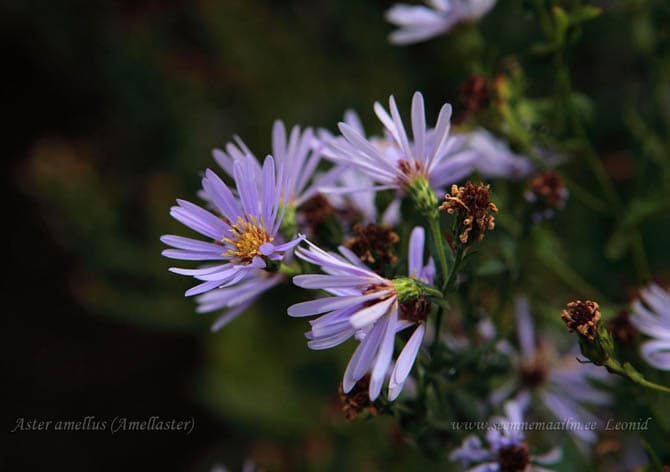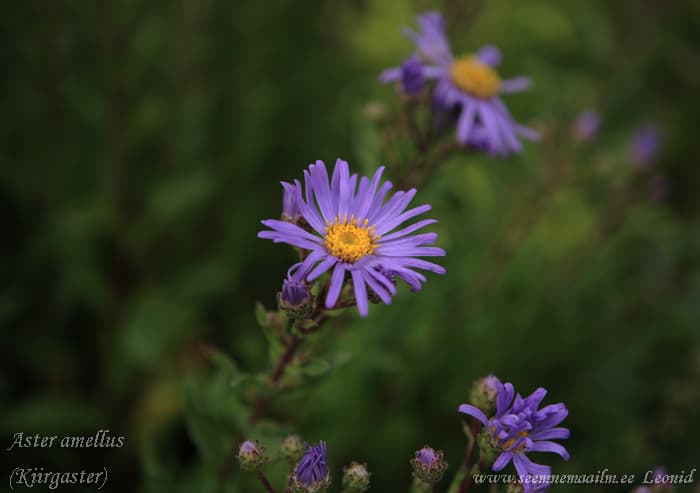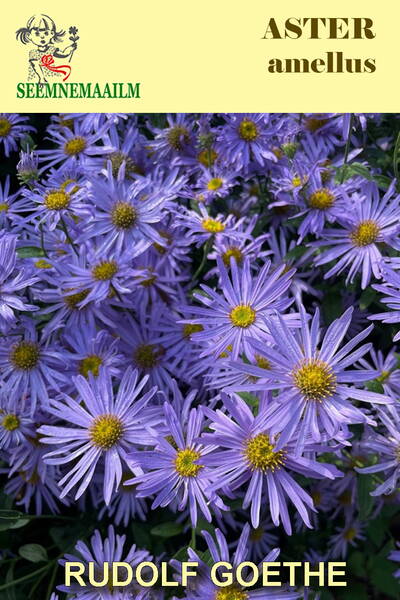Do you dream that your garden will be in bloom until late autumn? Then the aster "Rudolf Goethe" will become an indispensable assistant.
Perennial. Plant height 50 cm. Flower diameter 5 cm.
From mid-summer until the first snow, it will bloom its semi-double basket inflorescences with a golden yellow center. Its flower bushes are very compact and will look great framing a path in the garden, or performing a solo part on the lawn.

SOWING: in March-April for seedlings. 1.0 g = 800 seeds.
Seeds require preliminary stratification: sow the seeds on the soil surface, cover with glass and place in the refrigerator (temperature +5 + 7 ° C). Crops are kept under such conditions for 21 days, and then transferred to room conditions. In the phase of 1-2 true leaves, the seedlings dive. In the phase of 5-6 true leaves, the plants are planted in a permanent place, according to the scheme 20x30 cm. Young plants bloom in 1-2 years.
MAINTENANCE: Prefers nutritious soils with good moisture, but not wet. Plants need fertilizer and are very responsive to lime. For top dressing, it is recommended to use a complex mineral fertilizer that provides the necessary nutrition.
In one place, asters are grown for 5-6 years, after which the bushes are rejuvenated. In the budding phase, fertilizing with phosphorus and potash fertilizers is necessary (5 g per 1 m2).
FLOWERING: July-September.

Italian Aster - Aster amellus.
It grows in Central France, in Italy, in the countries of South-Eastern Europe, in the Caucasus, in Transcarpathia, in Asia Minor and Western Siberia along the edges, in rare, open places, on calcareous slopes in gravel soil. In natural habitats often grows with Carlina acaulis, Aster linosyris.
Inflorescences are large: up to 4-5 cm in diameter in loose corymbs. Each inflorescence bears 10-15 inflorescences-baskets, so the plant is densely covered with them. Reed flowers are lilac-blue, tubular - yellow. Blooms from mid-July to September (average 60-65 days).
* Late September - The Best Time to Plant Perennial Asters.
With the right selection of species, these plants will adorn your garden throughout the season.
Flowering Timeline of Perennial Asters:
-
Alpine Aster (Aster alpinus): Blooms from late May. Height: 20-60 cm. Petals (ray flowers) are white, violet, or bluish.
-
Italian Aster (Aster amellus): Blooms from mid-July. Height: 60 cm. Flowers form loose clusters with lilac-blue petals.
-
Sedum-leaf Aster (Aster sedifolius): Starts flowering in late July. Height: 100-120 cm. Flower heads are arranged in panicles with lilac-blue petals.
-
New York Aster (Symphyotrichum novi-belgii): The most common in our gardens. Blooms from mid-August to late October. Forms large, nearly triangular bushes (90-150 cm tall) with sturdy stems and 2-3 cm wide flowers in white, blue, lilac, violet, deep pink, red, or purple.
-
Bushy Aster (Symphyotrichum dumosum): Blooms from mid-September. Height: 20-50 cm. Neat, nearly spherical bushes covered in bright flower clusters. Petal colors include pale lilac, white, pink, blue, and crimson-purple.
-
New England Aster (Symphyotrichum novae-angliae): A giant (150-180 cm tall) blooming from mid-September until hard frosts. Sturdy, self-supporting bushes with 3-5 cm flower heads in dense panicles. Ray flowers are pink or lilac-pink, while the disc flowers (center) can be yellow, reddish-brown, or purple—unlike other asters.
Planting Tips:
-
Sunlight: Choose open, sunny locations—shade leads to poor flowering and powdery mildew.
-
Soil: Thrives in loamy soil, dug to a depth of 20 cm.
-
Longevity: Can grow in the same spot for 3-5 years without replanting.
Tip: Combine early and late varieties for continuous color from spring to frost!
Why Plant in Late September?
* Cool temperatures reduce transplant shock.
* Roots establish before winter for vigorous spring growth.
* Optimal moisture conditions in autumn.
Note: many aster species have been reclassified to the genus Symphyotrichum, though the traditional name "Aster" remains widely used in gardening.












